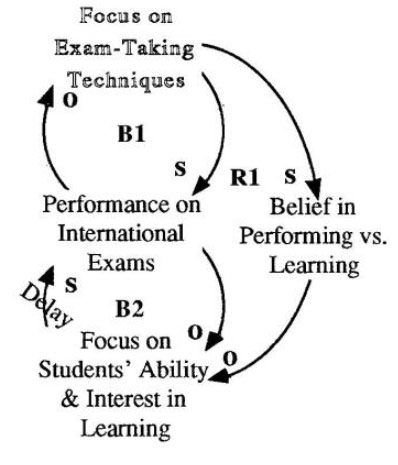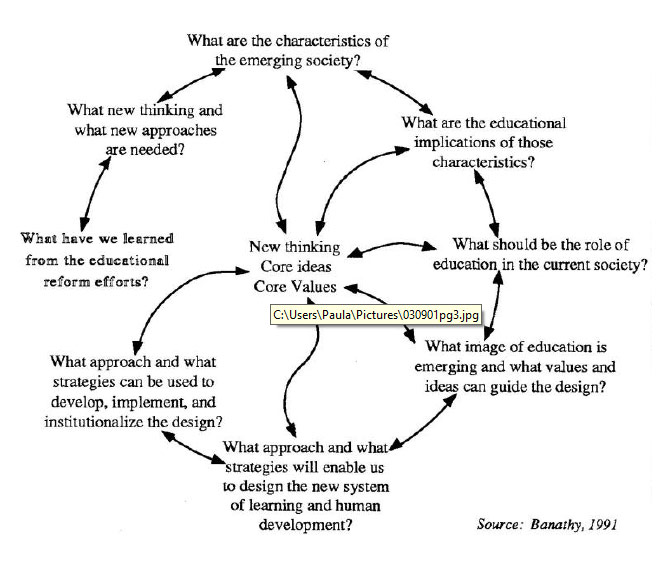“Our only real hope to survive and thrive in the increasingly tough world of global business is to have the world’ s best managers and workers in our industrial companies.”
—George A. Weimer
The best managers are not just those who can address today’s problems, but those who will learn to deal with the changing paradigm of tomorrow—managers who will be the most flexible, open, and able to support and encourage the development of a learning organization. Achieving such objectives will require much more from our educational system than current reforms demand. It will require a fundamental shift in thinking about the purpose and value of education, and how the educational system should fit into the rest of society.
Current Fix-it
Many current reforms call for various changes in the system such as more financial investment and/or longer school hours. Some programs suggest allowing parents to choose schools and, through a voucher system (or equivalent), letting market forces determine quality. Still other reform advocates believe schools should simply go back to teaching the basics. A common assumption behind each of these proposals is that the basic design of our educational system is sound—it just needs some changes.
Therefore, most attempts to “fix” the educational system focus on the individual parts of the system and try to improve them, while believing the goal itself is to fix the broken pieces. As we faltered in our objective of educating students, we have focused on the stumbling as the problem to correct. This phenomena is called “error-correction error.”
Boston from New York City when you discover you have taken a wrong turn and are instead heading south to Philadelphia. An error-correction error would occur if you began focusing on not reaching Philadelphia, shifting your goal away from the original purpose of reaching Boston and focus instead on not committing the error again. The “fix” would be to pick a city, such as Albany, and head for it in order to avoid Philadelphia.
“Most attempts to fix’ the educational system focus on the individual parts of the system and try to improve them, while believing the goal itself is to fix the broken pieces.”
Most proposed educational reforms follow this same pattern. Rather than reexamining the fundamental purpose of the educational system, they focus on removing present ills such as low test scores, high dropout rates, low teacher morale, and low parental involvement. Proposals that fixate on the past and advocate going back to the basics are further examples of error-correction error. They don’t necessarily ask the question of where we should be headed today; instead they focus on correcting a course deviation that may be totally irrelevant to our current needs.
Because the causes of our current educational crisis are so complex and deeply embedded, only fundamental changes in the structure of the system will have lasting results. Lengthening the school day won’t help if students are not learning during the time they already spend in the classroom. Testing teachers won’t improve their skills if they were not well-trained in the first place, just as tightening standards and testing students will not make any difference if the standards are irrelevant to today’s needs.
There must be a profound shift in thinking and inquiry into the nature of change in education; otherwise, reform efforts might actually make things worse (see “Shifting the Burden of Re-form”). Attempts to “fix” low test scores, for example, may involve setting up focused classes on exam-taking techniques which can improve scores (B1). This, however, can reinforce a belief among students that education is about “performing,” and more fundamental ways to engage a student’s interest in learning will be lost.
The basic question remains: is incremental reform what we really need, or are we, as Bela H. Banathy suggests in his recent book Systems Design of Education, “still trying to rearrange the chairs on the deck of [a] sinking ship?” This is the critical question that must be addressed before we rush to “fix” the current crisis in education. Answering it will require us to step outside of the educational system and the current political arena; to shift our time horizon beyond the painful shortcomings of the present to see education in a broader social context.
Shifting the Burden of Reform

Attempts to “fa” low test scores through exam preparation can promote the belief that learning is about performing, and erode students’ interest in education.
Changing Needs of Society
One of the reasons the current educational system is not meeting today’s needs is because its basic structure was based on the requirements of an agrarian society. From that beginning, our schools adapted to meet the needs of an industrial society, producing workers who will work long hours and follow orders without challenging or questioning authority. As technology has advanced in the last few decades, however, society has shifted from producing goods to generating information and rendering services. Banathy argues that our educational system must be reexamined in the context of this cultural evolution to see how its role can be redesigned to meet society’s larger needs.
According to Banathy, the technological revolution has accelerated to the point that we have lost power over it—the wisdom and intelligence needed to guide the development of such technology have not developed along with it. Therefore, the key challenge for education is to nurture the sociocultural intelligence and wisdom to match the pace of the technological revolution. “Education creates the future generation, and that creation is shaped by the society of that generation,” Banathy explains. “We can say that education and the society are in a co-evolutionary relationship. There are times when an evolutionary imbalance exists between education and the society. Such is the case today.”
In examining the co-evolutionary relationship of our society and education, we must also question our current values and attitudes about education. In Japan, “education mothers” spend several hours each night helping their children with their homework, and Japanese students’ success reflects their parents’ efforts to encourage scholarship. “In America, we figure a kid either has it or he doesn’t at an early age, then channel the child into fast or slow learning groups,” says William Loxley, executive director of the International Association for Evaluation of Educational Achievement (Johnathan Levine, “Why Akio and Yves Beat Out Johnny,” Business Week, Sept. 14, 1992). In order for any reform to be successful, learning must become valued as a primary means for fulfillment and self-development.
A Shift in Thinking
This kind of connected, integrated view of education has been around since PAIDEIA of Athenian society, which was a lifelong transformation of the human personality that integrated every aspect of life. PAIDEIA, as Willis Hannan describes in his book Global Mind Change, aimed at the attainment of wholeness as a human being, embracing all domains of experience, including ethical, physical, cultural, social, mental, spiritual, economic, scientific, and technological. Robert Hutchins described PAIDEIA as a concept where “Education was not a segregated activity, conducted for certain hours, in certain places, at a certain time of life. It was the aim of the society…” (The Learning Society, 1968). Unfortunately, such a paradigm is underdeveloped in the United States today, where linear thinking dominates schools in their isolated environment.
System dynamics holds the potential to achieve this type of multifaceted view of education. Through systems thinking, students can learn they have the power to change the future—but that power can only be harnessed when their minds are first opened for learning. In the broadest sense, education as a system should be an integration of all resources and opportunities that enable the development of children and the continuous learning of adults. The current system enables children to learn while in school, but when they graduate they become alone in their pursuits (unless their employment offers opportunities for continual learning). The educational system needs to break out of its disjointed isolation and develop mutually beneficial relationships with other social systems, such as businesses.
Designing a New Future
In order to work toward improving and integrating our educational system, Banathy suggests first developing a clear vision of the future state of the system. This vision can then be clarified by forming a new image which will guide the design process. Banathy refers to the vision as the grand ideal, the underlying philosophy and inspiration that guides the imaging, while the image should capture a system of core values and ideas that elaborate on the vision and guide the system design (see “Map of the Design Journey”).
As this design journey proceeds, new thinking and core values will continuously evolve. They should guide the journey and at the same time be enriched and informed by it. The stages of the journey will likewise be interactive and recursive, creating an open process where we examine how we think about change, and further clarify the role and image of education.
Because it is constantly evolving, the journey of designing a new system will never end. Design is creative and decision-oriented; and Banathy believes “it is only the envisioning of an ideal educational image that will have the power to pull education into the 21st century” (see “Third-Wave School Systems: A Blueprint” on page 4 for an experimental model of a redesigned school).
Our Most Important Learning Organizations
It is becoming apparent that our nation’s schools are our most important learning organizations. Not only is it critical to train and prepare our workers for changing industries and a global economy, but the educational system can serve as a foundation for lifelong learning that can continue into the workplace.
Map of the Design Journey

A map of the design journey for a new school system. The center of the circle represents the core ideas, thinking, and values that will become part of the design. The questions along the outside mark the milestones of the journey.
As educational organizations strive to become learning organizations, they must work toward distinguishing between instances requiring adjustments and corrections, and situations which merit change and redesign. Banathy, applying Chris Argyris’ concept of single- and double-loop learning to education, says the thrust in single-loop learning is to maintain the system and “don’t rock the boat.” Double loop learning moves beyond boundaries and reexamines the vision, purpose, and necessary action. To redesign our current system, much double-loop learning needs to take place among everyone in the system—teachers, parents, administrators, businesspeople, and most of all, the learners themselves.
“There are currently many efficient schools; there are a number of effective schools; there are very few that are significant” (Don Glines and Kathleen Long, “Transitioning Toward Educational Futures,” Phi Delta Kappan, March 1992). Working to develop significant schools filled with learners and facilitators is a tremendous challenge; but to provide American companies with what they will need in the future, it is the only alternative.
For further reading about ongoing systems reform programs, see “Revitalizing the Schools: A Systems Thinking Approach,” Juneiluly 1991. Other reading: Banathy, Bela H. Systems Design of Education, (Englewood Cliffs, NJ: Educational Technology Publications, Inc., 1991). Global Mind Change by Willis Harman (Knowledge Systems, Inc., 1988) is avail-able through Pegasus Communications. To order a copy, or for additional resources, call our offices at (617) 576-1231.
